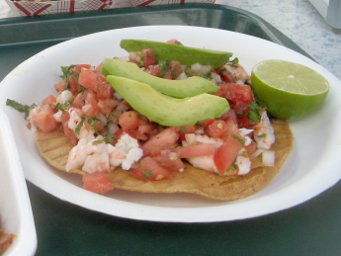Last updated: Sep 13th, 2011
Avocado is one of my favorite foods. Atypical for a vegetable or fruit, the avocado has a creamy texture and is delicately aromatic. Its high fat content makes it unusually filling.
The avocado, Persea americana, is native to the Americas, particularly central America and nearby regions. My favorite variety of avocado is the Haas avocado, a cultivar which has a fascinating story surrounding its origin. I prefer this variety because its small size is convenient, since avocados do not keep well after being cut.

Shrimp cevice tostada with avocado slices
Uses of Avocado:
Eating avocado plain: I often eat avocado on its own. My favorite way of serving avocado is to slice it in half, then slice into each piece and douse it in generous quantities of lime juice. I often add a little powdered coriander or cumin before squeezing the lime.
On tacos and tostadas: This one goes without saying; anyone who has tried avocado on a tostada will know what I'm talking about here! Pictured on the right is a shrimp cevice tostada, one of my favorite foods.
On sandwiches: Avocado makes an outstanding addition to most sandwiches, and is a healthier alternative to mayonnaise, ketchup, and other highly processed spreads. Greener avocados can be sliced and riper avocados can be crushed and spread onto a sandwich. Depending on what else is on the sandwich, avocado can impart a Mexican or California flavor and style to a sandwich.
Guacamole: Guacamole is a dip or spread which is made primarily from avocado, with a few other ingredients added in small quantities for additional flavor. I find that guacamole is an outstanding way to get rid of overripe or bruised avocados. My favorite way of making guacamole is to add lime juice and powdered coriander and cumin. I normally do not add tomatos, cilantro, parsley, or onions, but these can also make good additions--if added in small quantities.
Nutritional Value of Avocado:
All nutritional information in this section comes from the USDA nutrient database.
Avocado is high in fat, which makes it a highly caloric and filling food. According to the USDA Nutrient Database, a 200 gram avocado (equivalent to a smaller Haas avocado) has 322 calories, over 82% of which is from fat.
The avocado is highest in monounsaturated fat, and has relatively little saturated or polyunsaturated fat. Avocado has been shown in a control study to result in the lowering of LDL ("bad cholesterol") levels and an increase in HDL ("good cholesterol") levels. [Source]
Other important nutritional features of avocado include potassium, fiber, B vitamins, and vitamins E and K.
The protein content of avocado is also not to be ignored: one small avocado contains just over 4 grams of protein, unusually high for a fruit or vegetable. The amino acid profile of avocado is high in a number of essential amino acids, especially phenylalanine, with the one exception of tryptophan, found only in low concentrations in avocado protein.
Other Health Benefits of Avocado:
Besides its direct nutritional value, avocado shows promise of a number of health benefits. Avocado is rich in antioxidants, and a study has found that even the typically discarded seeds and skin are rich in antioxidants. [Source] A few studies have found some evidence of anti-cancer activity by chemicals extracted from avocado. [Source, Source, Source] The seed of avocado is also known to contain compounds that have antimicrobial effects. [Source]
Avocado and avocado oil have also been shown to enhance the absorption of carotenoids. [Source]
Comments are moderated. Follow Cazort.net's comment policy for your comment to be approved.
blog comments powered by Disqus